October 9, 2015 - 19:15

often struggle to focus during extended periods of conventional talking and listening conversation, so I wanted to do an out-of-the-box experimental essay. In class, we had a conversation with our hands, with water colors and colored pencils and markers and pens. I began by sharing my “essay,” a watercolor I painted that was inspired by DuBois. To get our minds going, I opened the space for us to share some texts from DuBois--anything that stood out to us or inspired us--and then make lists of the phrases and words that stuck with us from what our classmates shared. Mine are posted below. With the text rendering for inspiration, I offered art supplies, music by the Fisk Jubilee Singers (referenced by DuBois), and fifteen minutes to contemplate, write and/or do art. We then had a few minutes to share what we created. I took pictures of students’ artwork and asked them about it. Below I have created a quasi-art gallery of these images and comments--from the student-artists and myself.
My list of words and phrases: veil, be content to be servants, half-man, suicide of race, negro social responsiblity, ignorance, disenfranchise, bitter experience, prejudice, both must change, life treads on life and heart on heart, second sight, revelation, double conscioiusness, soul, educated negro = dangerous negro, education--danger, dissatisfaction, discontent, land of the color line, race, sympathy, flickering, fast unsteady stars, stalwart and gaunt, dark distress, the man groped for light, soul in search of itself, what in God's name am I on earth for, social problem, sweating black men, human progress, weapons, power of the ballot, preventing of the young from being trained to crime, changing.
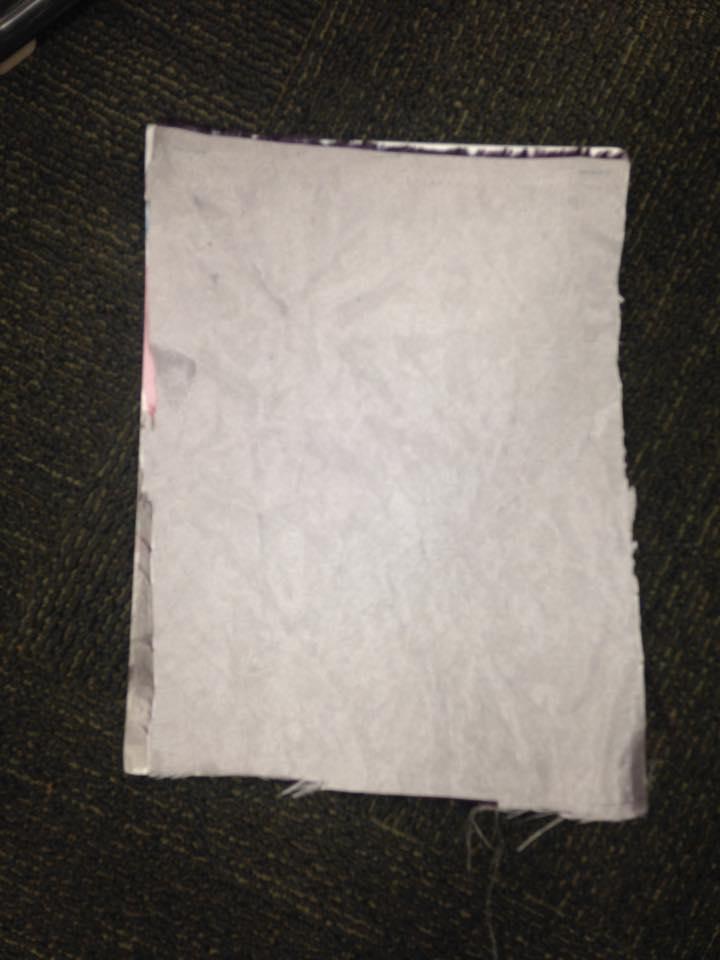
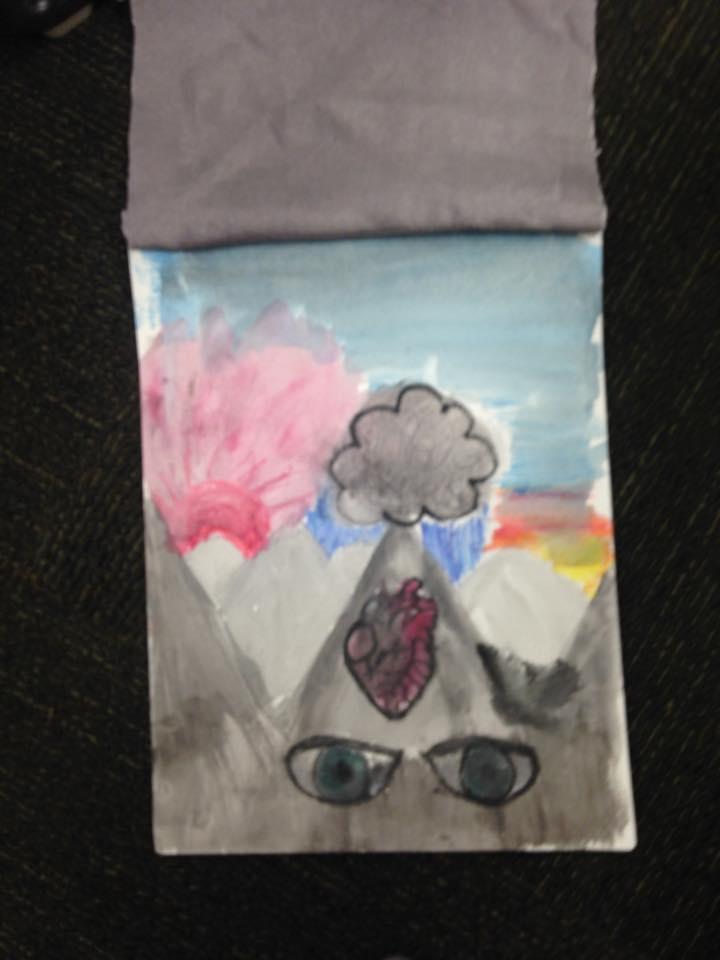
The Veil by Shirah Kraus
This piece is watercolors on watercolor paper with fabric and staples. DuBois writes about a veil and those who are on either side of it, a veil of racism. I decided to take this veil-idea literally and cover my painting with veil-like fabric. The upper image is covered by the veil and the lower uncovered. I was inspired by page 156 where DuBois writes:
“THIS is the history of a human heart,-the tale of a black boy who many long years ago began to struggle with life that he might know the world and know himself. Three temptations he met on those dark dunes that lay gray and dismal before the wonder-eyes of the child: the temptation of Hate, that stood out against the red dawn; the temptation of Despair, that darkened noonday; and the temptation of Doubt, that ever steals along with twilight. Above all, you must hear of the vales he crossed, - the Valley of Humiliation and the Valley of the Shadow of Death.”
I painted the red dawn, the darkened noonday, and twilight as well as the two valleys, the heart, and the eyes of the child. I made the child’s eyes big to show wonder. I added a lot of gray and dark colors. I liked DuBois’s imagery in this section and tried to illustrate that in my piece.
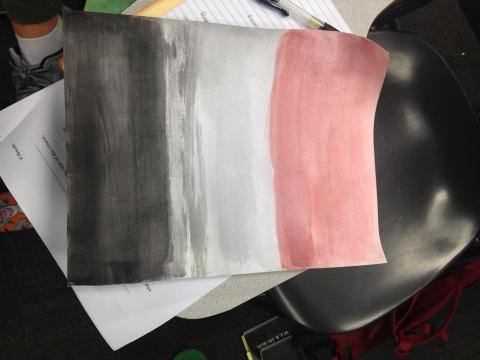
This is a watercolor by meerajay. It looks like a flag to me and I really like the bold colors.
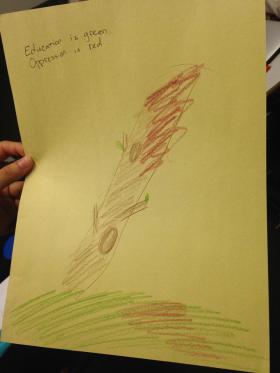
this is han yu's colored pencil drawing. Han was inspired by DuBois's narrative about Alexander Crummel (beginning page 156). Despite his education, Crummel was still discriminated against and oppressed. He grew from education (green grass), but also oppression. The red is also symbolic of blood. When I look at this drawing, I think about how we grow from education and oppression--both shape who we are. But also, oppression can stop our growth as in the red at the top of the tree.
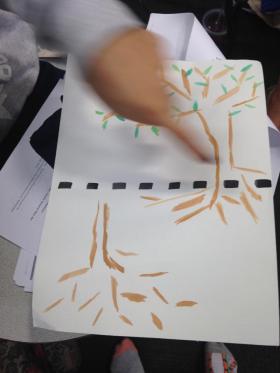
This is ttong's watercolor. ttong has had some experience with watercolors and chose to illustrate the color line. Like han yu, ttong chose to incorporate a tree motif to show how the color line separates blooming from bareness. I wonder why ttong chose to make the color line dotted. It reminds me of a street. On side of the street, people are free; on the other, people are oppressed.
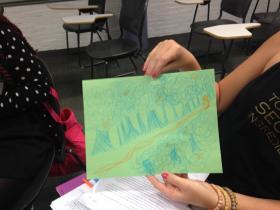
Starbelliedsneetch was inspired by DuBois's lines about searching for a soul. The tree motif persists. Here, also, there is a figure searching for its soul, which is in parts scattered amongst the trees: "In those sombre forests of his striving his own soul rose before him, and he saw himself,—darkly as through a veil; and yet he saw in himself some faint revelation of his power, of his mission. He began to have a dim feeling that, to attain his place in the world, he must be himself, and not another" (12). Also, DuBois describes, "the soul in search of itself" (162). This colored pencil drawing reminds me of Pocohontas and when she runs through the trees as she sings "The Colors of the Wind." I love the way Starbelliedsneetch depicted this soul in pieces. Is it possible to be whole?
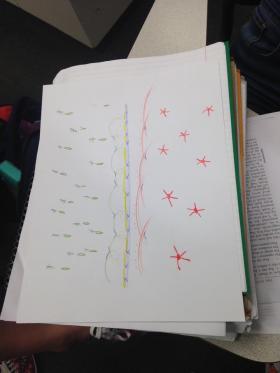
kregensburg (I think) drew this piece representing the color line. I'm not really sure what each of the symbols means, but it kind of reminds me of a river and a fence, similar to the barbed wire lining RCF and the river outside of the prison John Edgar Wideman visits. The river is a cruel jab at today's prisoners: "you can look, but you can't touch," it calls. Prisons are part of today's color line.
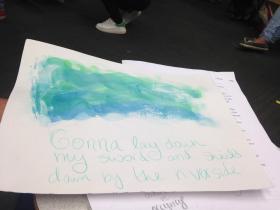
This is the watercolor that I did during class. I began by painting the color I was feeling and then it started to look like a river. I then wrote: "gonna lay down my sward and shield down by the riverside." I was inspired by the Fisk Jubilee Singers's music which reminded me of spirituals that I would sing at summer camp, often with Hebrew words and layered parts. DuBois writes about the beauty of negro music, and I think black music and culture should be appreciated and valued by society. I also like the message of peace and hope to create a world in which all people may know peace and justice.

Comments
Arts of Resistance
Submitted by jschlosser on October 22, 2015 - 11:02 Permalink
All of these strike me as various arts of resistance: visualizations of the unseen (the color line) that also take some responsibility and owndership over the unseen by making it visible, depicting and containing it. DuBois undertakes a similar project by putting into words what has been silenced. How might you incorporate these kinds of arts of resistance into your research project?
research project
Submitted by Shirah Kraus on October 23, 2015 - 13:59 Permalink
A my research project is becoming more concrete, I'm thinking about using images and texts both visually and perhaps theatrically. I think I could definitely look to these artworks, songs, and words as inspiration.